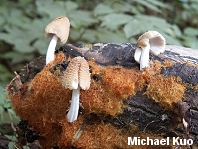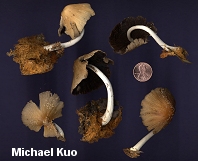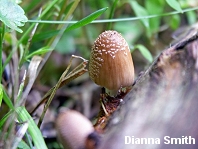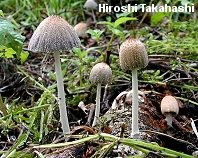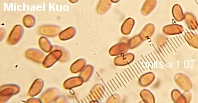| Major Groups > Gilled Mushrooms > Dark-Spored > Coprinoid Mushrooms > Coprinellus domesticus |

|
Coprinellus domesticus: The Retro Inky [ Basidiomycetes > Agaricales > Psathyrellaceae > Coprinellus . . . ] by Michael Kuo Orange shag carpeting had a run of popularity in the seventies, but it is thankfully behind us now, along with cactus lamps and macrame wall hangings. Somebody needs to tell Coprinellus domesticus, however; it routinely lays down a hairy carpet of bright orange on dead logs in the forest. The carpet is called an "ozonium," and when prominently laid out, there is no mistaking it. Coprinellus domesticus and the similar Coprinellus radians create this extravagant display; they are best separated with a microscope (see comments below). Specimens of both species are found, however, sans ozonium--and when this is the case they join the ranks of the many indistinguishable grayish coprinoid mushrooms growing on wood, and identification begins to hinge on such things as the microscopic structure of the granules and scales on the cap surface. Coprinellus domesticus, along with a few other mushrooms like Peziza domiciliana, sometimes colonizes damp indoor substrates like basement rafters or bathroom carpets. About twice a year I get e-mails describing these mushrooms. If these worried messages can serve as scientific evidence (they can't), it may be the case that the ozonium is less prominent or absent in indoor fruitings . . . or perhaps all of my e-mailers have bathroom carpet laid in the seventies, and simply don't notice it. Coprinellus radians has larger spores (8.5-11.5 x 5.5-7 µ). It is also widely distributed in North America. Readers who own David Arora's wonderful Mushrooms Demystified (1986) will notice that he describes what is probably a different mushroom as "Coprinus domesticus"; the species he describes has slightly larger spores, veil remnants that are less prominent and more easily washed away, and, apparently, lacks the ozonium. He notes confusion in the literature regarding the species, however, and says his use of the species label Coprinus domesticus "must be regarded as tentative" (350). Coprinus domesticus is a synonym. Description: Ecology: Saprobic, growing gregariously or in small clusters (occasionally alone) on decaying hardwood logs; summer and fall (or over winter on the West Coast); widely distributed in North America. Cap: To 7 cm across; oval when young, expanding to convex or conical; when young honey yellow and whitish toward the margin, in age gray with a brownish center; covered with whitish to brownish universal veil fragments in the form of small scales or granules; finely grooved or lined from the margin nearly to the center. Gills: Attached to the stem or free from it; white at first, but soon gray, then blackish; eventually deliquescing (turning to black "ink"); close. Stem: 4-10 cm long; up to 1 cm thick; equal, with a slightly swollen base; smooth; white; hollow; sometimes with a volva-like rim at the base; usually arising from a mat of orange fibers. Flesh: Very thin; fragile. Odor and Taste: Not distinctive. Spore Print: Black or blackish brown. Microscopic Features: Spores 6-9 x 3.5-5 µ; elliptical; smooth; with an eccentric pore. Basidia 4-spored; surrounded by 4-6 brachybasidia. Pleurocystidia subglobose to subcylindric; up to 120 x 65 µ. Cheilocystidia variously shaped; up to 100 x 60 µ. Pileipellis an epithelium. Caulocystidia lageniform. Veil elements sausage-shaped to almost subglobose (when terminal); sometimes with thick walls. REFERENCES: (Bolton, 1788) Vilgalys, Hopple & Jacq. Johnson, 2001. (Saccardo, 1887; Kauffman, 1918; Arora, 1986; Breitenbach & Kranzlin, 1995; Uljé, 2003; McNeil, 2006.) Herb. Kuo 07010301. This site contains no information about the edibility or toxicity of mushrooms. |
© MushroomExpert.Com |
|
Cite this page as: Kuo, M. (2008, February). Coprinellus domesticus. Retrieved from the MushroomExpert.Com Web site: http://www.mushroomexpert.com/coprinellus_domesticus.html |
